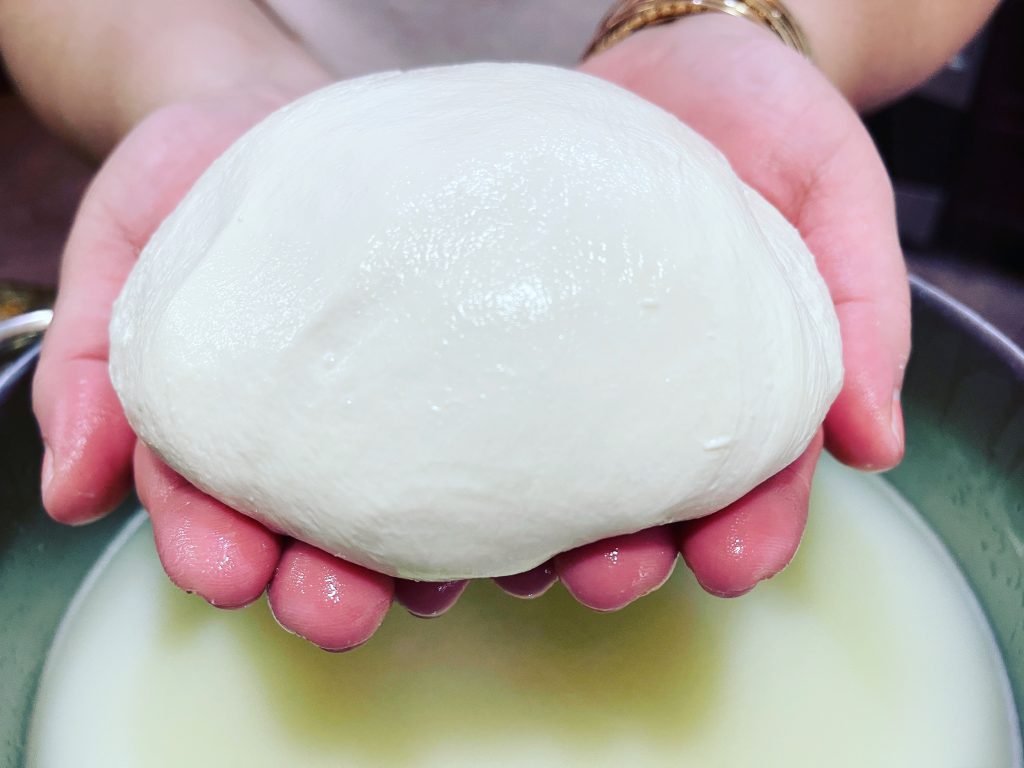All products featured on Domestic Gourmet are independently selected. I may earn an affiliate commission when you buy through links on this site.
When making mozzarella, what is most important is the whole milk you choose; use raw (found at your local farmer’s market or specialty grocer) or pasteurized but not ultra-pasteurized. It’s a more straightforward process than some recipes initially led me to believe. It hit me when a family member struggled to make mozzarella, running all over the place trying to find the “right” heavy cream, thinking that was where she was going wrong. I felt I could simplify the process for her and anyone else struggling to make this delicious cheese, thinking about how people worldwide make cheese straight from cow’s milk using rennet or cultures and citric acid. There’s no need for heavy cream.
During this past year of perfecting my cheesemaking, I got the feel of how newly formed curds are supposed to feel, the pulling and folding, and how to handle the hot whey (wear gloves!). I learned to take my time and enjoy the process, and after a few times, I realized it was the same amount of time every time, and it only amounted to 10 minutes more than your quick 30-minute recipes. Not bad.
Both liquid animal and vegetable rennet work just as well. Remember that if you intend to serve your homemade cheese to vegetarians, you’ll want to stick to vegetable rennet.
Buon appetito!

How To Make Mozzarella
Keeping it simple with a few ingredients and a little extra time will yield delicious mozzarella anytime.
-
-
- SERVINGS: 14oz
- COOK TIME: 40 mins
-
Equipment
-
-
- 5 Qt. Pot
- Whisk (or slotted spoon)
- Instant read thermometer
- Chef’s Knife
- Colander
- Medium-Large Size Mixing Bowl
- Two Small Mixing Bowls
- Optional: Exam or Kitchen Gloves
-
Ingredients
-
-
- 1 gallon raw whole cow’s milk can be substituted with pasteurized whole milk but not ultra-pasteurized milk
- ¾ cup cold water
- 1½ tsp citric acid
- ¼ tsp liquid animal or vegetable rennet
- 1 tbsp kosher salt
-
Instructions
- Combine ½ cup of cold water and 1½ tsp of citric acid in a small mixing bowl, and stir until the water has somewhat cleared and the citric acid doesn’t settle to the bottom of the bowl.
- Pour the entire gallon of milk into the pot and stir the cold milk with a whisk or slotted spoon. While stirring, pour in the citric acid and water mixture and stir until fully dispersed, about 10-15 seconds.
- Cook over medium-low heat, stir periodically and check the temperature of the milk using an instant-read thermometer until the temperature reaches 90 degrees, approximately 5-8 minutes.
- In a small mixing bowl, combine ¼ cup of water with ¼ tsp of liquid rennet.
- Once the milk has reached 90 degrees, stir in the water and rennet mixture using a whisk or slotted spoon. Stir continuously for 30 seconds and no longer to avoid breaking up the already forming curds.
- Remove the pot from the burner, cover it with the lid, and set it aside for 10 minutes.
- Uncover the lid. You should see a thin line of clear liquid encircling the single large milk curd from the pot.
If you do not see this, replace the lid and leave it for another minute or two. - Cut from top to bottom 5-6 strips using a chef’s knife. Then from side-to-side, cut 5-6 strips. It should look like a crosshatch pattern (think flannel squares).
- Replace the pot to the burner and, over medium-low heat, cook until the temperature reaches 105 degrees. Using an instant-read thermometer, check the temperature periodically.
For an accurate reading, ensure that the thermometer’s tip is neither too close to the bottom nor the top of the pot. - Once the temperature reads 105, remove the pot from the heat and set it aside for 5 minutes.
- While the curds are resting, place a colander in a large pot.
- After the 5 minutes, using a slotted spoon or your hands, remove the milk curds from the liquid whey and place them into a colander. Squeeze out as much liquid as possible and set it aside.
- Add salt to the whey (remaining liquid) in the pot, raise the temperature to medium heat, and heat to 180 degrees.
Again, stir periodically and check the temperature with the instant-read thermometer. - In a medium-large mixing bowl, add the mozzarella curd and cover with the hot whey. Let sit for 20-30 seconds.
- Using your hands, lift the mozzarella out of the hot whey by one side. Allow the weight of the mozzarella to pull itself down naturally, and then fold the mozzarella in half.
- If the mozzarella feels stiff, set it back into the hot whey or add more hot whey to the bowl to help heat it until it’s easily pliable, about 10-15 seconds more.
- Continue pulling and folding 3-4 times.
With the mozzarella folded in half, use your thumbs to pull the top of the mozzarella out and down. Use your remaining fingers to tuck the mozzarella back underneath and up into itself. - Continue this manual pulling until the mozzarella is shiny and tight. Pinch the bottom of the mozzarella closed, place it into a bowl, and cover with room temperature whey.
- Serve within 2 hours or refrigerate for up to 5 days.
How to store:
-
-
- If storing mozzarella in the refrigerator, store it in an airtight container covered in whey, olive oil, or wrap it tightly in plastic wrap.
-
Pro-tip:
-
-
- The hot whey, at 180 degrees, is as close to being as hot as a cup of coffee from your favorite cafe, which is roughly 190-205 degrees. To give you an idea of what the hot whey feels like.
Latex gloves offer a nice buffer between your hands and the heat. If you find it to be still too hot to handle, try either rubber kitchen gloves or putting mittens on underneath a pair of latex gloves.
- The hot whey, at 180 degrees, is as close to being as hot as a cup of coffee from your favorite cafe, which is roughly 190-205 degrees. To give you an idea of what the hot whey feels like.
-
No Waste:
-
-
- The remaining whey can be used in soups, smoothies, marinades and can substitute for water in any recipe. Whey is full of protein and amino acids; store it in the refrigerator for up to a week or freeze it for 6 months.
-
Notes
How to include your child(ren): This recipe is science in action by teaching them how to turn a liquid into a solid! Your little chef(s) can practice fine motor skills by mixing citric acid and rennet into water. Celebrate when they don’t spill it, and celebrate when they do. “Wow, you mixed that powder in and didn’t lose a drop!” or “Wow, you are building those hand muscles! You may have spilled some, but your muscles will remember, and I bet you’ll spill less or none at all next time!” You’ll be building their self-confidence while also connecting.
Older chef(s) can take charge of stirring and monitoring the temperature. Let them get a feel for the curds at the beginning stage while 90 degrees and again at 105 degrees. Using gloves to protect their hands from the heat, let them pull and fold. After years of playing with slime and play-doh, they’re ready for mozzarella.

More About Ciji
Ciji Castro, the talented Latina entrepreneur, celebrates her heritage through mouthwatering Cuban and Puerto Rican recipes. With a trailblazing spirit, she’s a standout figure in the culinary world. Recognized as the foodie mastermind behind Domestic Gourmet, she was named “Woman To Watch 2023” by Tampa Magazine. Her success shines through prestigious partnerships with Four Seasons, Ritz-Carlton, Michelin Guide, NBC, and Disney on Ice. Collaborating with Michelin-starred chefs and restaurants, Domestic Gourmet has garnered praise from patrons and industry professionals. Her captivating personality and passion for food inspire aspiring chefs and home cooks worldwide.

